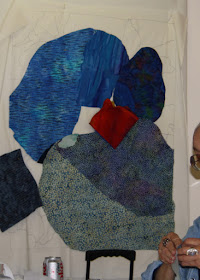 Our next door neighbors asked us to join them in visiting Linwood Gardens which is home to an extensive collection of tree peonies. Now I have seen peonies but these were different than the kind that pop up every spring. They have rough bark stems and grow larger each year. Joe and Sharon have now added three to their extensive beautiful gardens. They like a little shade so are perfect for this area. They are just stunning and come in quite a variety of colors! I took probably 200 pictures with a lot of macros in the bunch for inspiration! The flowers were large like hibiscus and you can see all the colors above. My Picasa album has about 65 pictures of all the different colors.
Our next door neighbors asked us to join them in visiting Linwood Gardens which is home to an extensive collection of tree peonies. Now I have seen peonies but these were different than the kind that pop up every spring. They have rough bark stems and grow larger each year. Joe and Sharon have now added three to their extensive beautiful gardens. They like a little shade so are perfect for this area. They are just stunning and come in quite a variety of colors! I took probably 200 pictures with a lot of macros in the bunch for inspiration! The flowers were large like hibiscus and you can see all the colors above. My Picasa album has about 65 pictures of all the different colors.There will be random thoughts about dyeing, marbling and quilting. Hopefully there will be some information that is new to people. Nature is my inspiration and because of that, I reserve the right to publish lots and lots of pictures of animals, birds, butterflies and plants!
Monday, May 30, 2011
You Learn Something New Every Day -- Today, Tree Peonies!
 Our next door neighbors asked us to join them in visiting Linwood Gardens which is home to an extensive collection of tree peonies. Now I have seen peonies but these were different than the kind that pop up every spring. They have rough bark stems and grow larger each year. Joe and Sharon have now added three to their extensive beautiful gardens. They like a little shade so are perfect for this area. They are just stunning and come in quite a variety of colors! I took probably 200 pictures with a lot of macros in the bunch for inspiration! The flowers were large like hibiscus and you can see all the colors above. My Picasa album has about 65 pictures of all the different colors.
Our next door neighbors asked us to join them in visiting Linwood Gardens which is home to an extensive collection of tree peonies. Now I have seen peonies but these were different than the kind that pop up every spring. They have rough bark stems and grow larger each year. Joe and Sharon have now added three to their extensive beautiful gardens. They like a little shade so are perfect for this area. They are just stunning and come in quite a variety of colors! I took probably 200 pictures with a lot of macros in the bunch for inspiration! The flowers were large like hibiscus and you can see all the colors above. My Picasa album has about 65 pictures of all the different colors.Saturday, May 28, 2011
Summer is Coming!
 I started this jacket about a year ago as part of a turquoise jacket challenge. As I am working on quilting the lion quilt on my home machine, I picked this up to continue on and surprisingly finished the back and the two sleeves. I made some progress on the fronts as well and am quite pleased! It will be great with blue jeans. I am using some of my marbled (back lower right) and salt dyed fabrics (back lower right and top of front) in this jacket. You might have to double click on the picture to see the detail!
I started this jacket about a year ago as part of a turquoise jacket challenge. As I am working on quilting the lion quilt on my home machine, I picked this up to continue on and surprisingly finished the back and the two sleeves. I made some progress on the fronts as well and am quite pleased! It will be great with blue jeans. I am using some of my marbled (back lower right) and salt dyed fabrics (back lower right and top of front) in this jacket. You might have to double click on the picture to see the detail!Today was the day to meet with our Project Iron Quilter judge, Genie Barnes, who is well known to the quilt world! She was extremely helpful in getting some loose ends tied up so a week from today the big competition will begin!!
 This is a closeup of the sleeves. The panels in the middle are cut from one long strip of Hmong embroidery from Laos that I bought from Priscilla some time ago. They were perfect for this. I still have to add a little bling to outline the strips (some shiny cording or yarn) but really like the striped fabric next to the panelled fabric. Amazingly, it has just about all the colors! I will be adding a little bling to the back as well.
This is a closeup of the sleeves. The panels in the middle are cut from one long strip of Hmong embroidery from Laos that I bought from Priscilla some time ago. They were perfect for this. I still have to add a little bling to outline the strips (some shiny cording or yarn) but really like the striped fabric next to the panelled fabric. Amazingly, it has just about all the colors! I will be adding a little bling to the back as well. Marcia has made significant progress with her latest jet trails quilt and it gets better all the time!
Marcia has made significant progress with her latest jet trails quilt and it gets better all the time! Bill alerted us to the fact that he had stirred up the pasture when mowing where this fawn was hiding in the tall grass. This is a frequent occurrence in spring. According to Bill, the doe leaves the fawn and the fawns don't move until she comes back to get them. He commented that they have no scent to attract coyotes and foxes at this stage in their life and are safe until mom returns which she did. He or she was just so beautiful -- probably smaller than a beagle at this stage.
Bill alerted us to the fact that he had stirred up the pasture when mowing where this fawn was hiding in the tall grass. This is a frequent occurrence in spring. According to Bill, the doe leaves the fawn and the fawns don't move until she comes back to get them. He commented that they have no scent to attract coyotes and foxes at this stage in their life and are safe until mom returns which she did. He or she was just so beautiful -- probably smaller than a beagle at this stage.Wednesday, May 25, 2011
Sunsets, Finally....
 This first quilt (Sunset 1)is one that will be in the GVQC quilt show which will be held the weekend following Memorial Day at RIT's Gordon Field House.
This first quilt (Sunset 1)is one that will be in the GVQC quilt show which will be held the weekend following Memorial Day at RIT's Gordon Field House.
This is the second sunset quilt (Sunset II) which I just finished quilting and will sew on the facing tonight. This one was originally made at the request of my eldest daughter who has since decided it no longer is her color scheme. She thinks they are too bright for the beach house as well, while I think either of them would look gorgeous on those big white walls we have! Oh well, these decisions have to be passed through her as she is half owner!

This is a closeup of the quilting in Sunset II which I don't think is as good as Sunset I but at least it is done finally. I have had these tops done for probably five or six years but couldn't decide how to quilt them. Done.... The blocks itself is the Five Easy Pieces block from Margaret Mitchell's book of the same name. All the interpretations are mine however and don't vaguely match anything in the book!

Priscilla finally her leaves quilt which will be hanging in the Parallax show being held in Rochester.
Monday, May 16, 2011
Lions....All Pieced
 The quilt top is finally done except for some miscellaneous fix-ups of areas. I have already done a good deal of applique in strategic areas which were not looking as they should. You can probably tell if you look at some of the old blog photos.
The quilt top is finally done except for some miscellaneous fix-ups of areas. I have already done a good deal of applique in strategic areas which were not looking as they should. You can probably tell if you look at some of the old blog photos. The top is currently 75 inches wide by 55 inches high but it will probably shrink some during quilting. I intend to baste the top later this week and then start the machine quilting. I prefer to do my "thread painting" at this stage and incorporate it into the quilting rather than do the intense machine embroidery earlier. You have to be careful doing it during the final quilting as you can badly warp a quilt if you don't do the quilting relatively evenly.
In the meantime, I am cleaning up the total disaster that I call my sewing room. I can walk to the sewing machine now without taking my life in my hands and watching my every step!! I will be working on machine quilting another quilt for the next couple of days. I have done some quilting on it already to stabilize it but it will require a lot more!
 Marcia is working on another of her jet trail pieces -- the colors are just beautiful and this is a big one.
Marcia is working on another of her jet trail pieces -- the colors are just beautiful and this is a big one.Priscilla was putting the final touches on her quilt. She is certainly the trooper!!
Friday, May 13, 2011
75th Anniversary Luncheon at Genesee Valley Quilt Club
 Jenna Darlak is modeling her hat that she wore to our special 75th anniversary luncheon meeting of GVQC!!
Jenna Darlak is modeling her hat that she wore to our special 75th anniversary luncheon meeting of GVQC!! We had flowers at each table in bone china tea cups donated by club member Ruth Santos, whose husband also supplied the entertainment. It was truly charming and hopefully we will start a tradition of wearing hats to our May meeting (and maybe others). I felt terribly English even though I didn't have a hat!! Can't get enough of those old fashioned traditions!
We had flowers at each table in bone china tea cups donated by club member Ruth Santos, whose husband also supplied the entertainment. It was truly charming and hopefully we will start a tradition of wearing hats to our May meeting (and maybe others). I felt terribly English even though I didn't have a hat!! Can't get enough of those old fashioned traditions! Rory is also modeling her hat here!
Rory is also modeling her hat here!
Mary Shaw, one of our long term members won the 75th anniversary raffle quilt. Truly deserved by honorary member Mary.

Mary Love and her mom Brenda were both decked out in their hats as well!

Judy Laurini was named one of our new honorary members and was sporting this hat!

I took this one from behind so I don't know who was wearing it but they were sitting right in front of me at the next table! I took pictures of some other hats but didn't get the exposure right so my apologies to those who didn't get pictured!

There were lots and lots of comfort quilts marching across the stage.
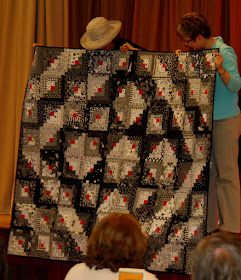
I loved this black and white log cabin.

This was a quilt made for Alzheimers' patients. Each one of the squares has a different texture and the patients like to stroke the different textures and find it comforting.

I LOVED this quilt. Very simple and graphic in nature. The quilter (whose name I didn't get) actually made two single bed sized quilts with buttons that hooked them together so that her husband and her would each have their own quilt!

This was a lovely pineapple quilt.

Ann Nash is one of our finest quilters and this quilt was just wonderful -- all hand appliqued and hand quilted (the next picture). To see these wonderful quilts, come to our wonderful quilt show the first weekend in June at the RIT Field House -- it will be open Friday, Saturday and Sunday and will have over 600 quilts and 41 vendors -- as big as any regional show you will find!!

This shows the quilting on the above quilt. Ann is originally from Wales and is known for her whole cloth quilting in the Welsh tradition!

After our show and tell, we had a wonderful catered luncheon -- easily the best catered meal I have had. It was done by a local caterer - Lorraines -- and the food was delicious and they were serving 280 people!!!!
Sunday, May 8, 2011
More Spring Images from Western Upstate NY
 Our backyards are filled with the awakening of spring -- flora and fauna. The purple trillium is really looking nice. The leaves are much bigger and differently shaped than the white trillium.
Our backyards are filled with the awakening of spring -- flora and fauna. The purple trillium is really looking nice. The leaves are much bigger and differently shaped than the white trillium. The white trillium is just peaking this week and are all over our back "woods" as well as our neighbor's.
The white trillium is just peaking this week and are all over our back "woods" as well as our neighbor's.
The next door neighbor has beautiful bleeding hearts back in his naturalized area. You may remember that his gardens were part of the Rochester garden tour last year and we had a couple of hundren people coming through.

Joe has bird feeders as well as suet to bring many birds. I think this is a Hairy Woodpecker male as he seemed a little large for a downy but I could be wrong here.
 A sure sign of spring is that the Goldfinches have their mating plummage and were enjoying treats at the feeder. There were also some purple finches there as well today.
A sure sign of spring is that the Goldfinches have their mating plummage and were enjoying treats at the feeder. There were also some purple finches there as well today.Saturday, May 7, 2011
The Lions' Story
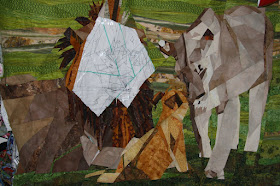 The lions are progressing. They still are only in sections but I only have six sections left -- important ones but smaller ones than those I have done. I have been doing a lot of piecing to make "fabric" for the manes.
The lions are progressing. They still are only in sections but I only have six sections left -- important ones but smaller ones than those I have done. I have been doing a lot of piecing to make "fabric" for the manes.Well, I thought I would do a little summary of my process for doing the lions. It is based of course on the technique that Ruth McDowell details in many of her books. I do things a bit differently though as probably anybody does when they have worked with someone else's process.
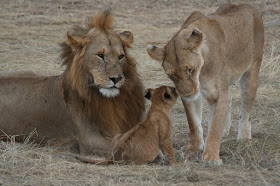 I first find a photo I really like and this is really important. I try to find a photo that has a good range of values in it. I then use Photoshop (or any photo program) to change the photo to black and white (desaturate the color). I then "posterize" it so that there are larger areas of one shading. I again check the picture to make sure there is enough differentiation of the areas and that it hasn't gone to far to "cartoon" like. Next I take the black and white image to Staples and have them blow it up to double size. I use this as my base. I use transparent plastic to trace around the different clumps of shading, getting as much detail differentiation as I can. I then put a piece of tracing paper over this and start deconstructing the drawing by trying to find large linear components. After I have sub-divided the drawing using these large linear elements, I just keep subdividing until you can begin to see the original image in this large straight line piece. I have used curves in one piece as well but do prefer the more abstract representations created with the straight lines.
I first find a photo I really like and this is really important. I try to find a photo that has a good range of values in it. I then use Photoshop (or any photo program) to change the photo to black and white (desaturate the color). I then "posterize" it so that there are larger areas of one shading. I again check the picture to make sure there is enough differentiation of the areas and that it hasn't gone to far to "cartoon" like. Next I take the black and white image to Staples and have them blow it up to double size. I use this as my base. I use transparent plastic to trace around the different clumps of shading, getting as much detail differentiation as I can. I then put a piece of tracing paper over this and start deconstructing the drawing by trying to find large linear components. After I have sub-divided the drawing using these large linear elements, I just keep subdividing until you can begin to see the original image in this large straight line piece. I have used curves in one piece as well but do prefer the more abstract representations created with the straight lines.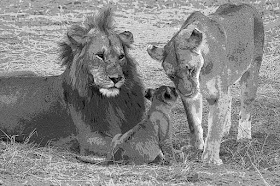
This is the posterized version of the converted picture.
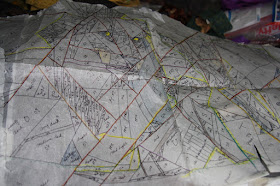 After I have gotten the tracing to where I am comfortable, I then take a picture of the tracing paper drawing. I determine how large I want to make the final piece at this point and use an online poster program to blow up the tracing paper image into the size I want. The lions took 49 pieces of paper (4 1/2 feet by 6 feet). If the final piece will be less that 3 feet by 4 feet, I will have Staples again blow up the image on their large copier and will make two copies (instead of using the poster program).
After I have gotten the tracing to where I am comfortable, I then take a picture of the tracing paper drawing. I determine how large I want to make the final piece at this point and use an online poster program to blow up the tracing paper image into the size I want. The lions took 49 pieces of paper (4 1/2 feet by 6 feet). If the final piece will be less that 3 feet by 4 feet, I will have Staples again blow up the image on their large copier and will make two copies (instead of using the poster program).I then use use a colored marker over the solid black lines to differentiate the sections. Now it is important to make sure all the lines on this original drawing are dark enough. Then I place a piece (usually have to tape a number of sections of freezer paper together) of freezer paper over the whole drawing with the shiny side facing up. I carefully tape it to the blownup drawing and then tracing using a thin black permanent marker all the lines onto the freezer paper. This will be my pattern. I then turn the freezer paper over and make all the tick marks so that I can put the pieces back together (see Ruth's books for her techniques here which I use religiously).
I now mark piece numbers on my tracing paper pattern using a section letter and a piece number. I then transfer these to the freezer paper pattern (not on the shiny side). After the freezer paper pattern is fully marked up, I then cut it into sections and place each section in plastic bags. If I have a second Staples copy of the whole pattern, I then cut it into sections and place the appropriate section in the plastic bag with the freezer paper section. If I have used the poster program I take the individuals sections and then photocopy the shiny side. This gives me a piece I can work on at the sewing machine (I have very tiny parts in my pieces). I pin up the master pattern on the wall and as I finish a section at the sewing machine, I will pin it to the appropriate area on the master pattern.
At this time I also make sure I have printed out a color copy of the original picture as well as a transparency of the original tracing paper pattern (both 8 1/2 x 11). I tape the transparency over the original picture and this helps with the individual color selections.
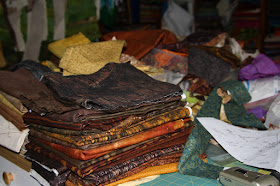
Working each section, I first put together a pallette of colors I think will work for this area (out of the huge selection I have chosen for the whole piece ahead of time). I will mark these color choices on the copies of the section sitting by my sewing machine. I will then cut the freezer paper pieces apart as I group all the pieces together that I want out of one of the color selections. I will pin them onto the fabric and then rough cut around giving at least 1/2 in around the piece. After I complete doing this for a section, I go to the ironing board and iron all the freezer paper pieces onto the appropriate fabrics. I then take the pieces back to my work area by the sewing machine and use a rotary cutter and ruler to make 1/4 inch seams all the way around. I then place them back into my plastic bags. I try to do the color matching during the day as I have found I make better choices.
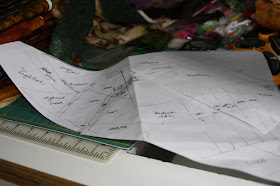 After I finish 3 or 4 sections, I use my pattern copy as a guide and start sewing the pieces together. It is a lot like doing jig saw puzzles but with careful marking and 1/4 in seams, they go together effortlessly no matter how small! There is a real danger to doing each section at a time and I do have to undo pieces when I put them up on the wall occasionally and at the end I will sometimes applique over a troubling area that is too hard to undo.
After I finish 3 or 4 sections, I use my pattern copy as a guide and start sewing the pieces together. It is a lot like doing jig saw puzzles but with careful marking and 1/4 in seams, they go together effortlessly no matter how small! There is a real danger to doing each section at a time and I do have to undo pieces when I put them up on the wall occasionally and at the end I will sometimes applique over a troubling area that is too hard to undo.I leave the freezer paper patterns in until the very end as many times I will use the pattern piece again to replace a color that didn't work. Also it helps to stabilize the piece which by this time has every bias imaginable (I am not terribly careful except on the large pieces to mark the grain lines -- I am thinking in the future that I would like somehow to have a grid on the paper that I use or the freezer paper ideally).
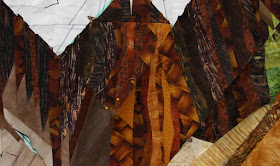
This is a closeup of the mane on the male lion.
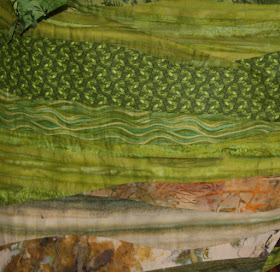
Another technique that I use is to make my own "backgrounds". I haven't done this on all my pieces but have found that when I have large areas to fill, I prefer to make my own fabric to fill these areas. I decide on the general color and range of values that I want to use and then I randomly put the pieces together using curved piecing methods to create in some cases fairly substantial yardage. I then use this like any other striped fabric. I have used this extensively in both the background for the lions and in the mane of the male lion as I wanted a more organic look. It does complicate the piecing process a bit as I like the stripes to generally match across a large area (which is generally made up of many small templates).





 The center of a white one!
The center of a white one!



